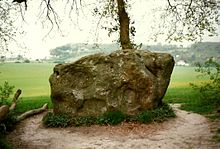 The Upper White Horse Stone | |
| Coordinates | 51°18′54″N 0°30′53″E / 51.314969°N 0.514735°E |
|---|---|
| Type | Monolith; putative Long barrow |
The White Horse Stone is a name given to two separate sarsen megaliths on the slopes of Blue Bell Hill, near the village of Aylesford in the south-eastern English county of Kent. The Lower White Horse Stone was destroyed prior to 1834, at which time the surviving Upper White Horse Stone took on its name and folkloric associations. Various archaeologists have suggested—although not proven—that the stones were each part of chambered long barrows constructed in the fourth millennium BC, during Britain's Early Neolithic period.
If the White Horse Stones were originally components of chambered long barrows, then they would have been erected by pastoralist communities shortly after the introduction of agriculture to Britain from continental Europe. Long-barrow building was an architectural tradition widespread across Neolithic Europe although comprised various localised regional variants; one of these was in the vicinity of the River Medway, examples of which are now known as the Medway Megaliths. The White Horse Stones lie on the eastern side of the river, along with the chambered long barrows of Little Kit's Coty House, Kit's Coty House, the (now destroyed) Smythe's Megalith, and the Coffin Stone, which may be a part of a fourth. Three other examples, the Coldrum Long Barrow, Addington Long Barrow, and Chestnuts Long Barrow, remain on the western side of the river. Excavation has revealed the existence of an Early Neolithic longhouse near to the stone.
By the 19th century, antiquarians were speculating that the Lower White Horse Stone may have taken its name from the White Horse of Kent, which they in turn believed was the flag of the legendary fifth-century Anglo-Saxon warriors Hengest and Horsa. Subsequent historical research has not accepted this interpretation. After the stone was destroyed, the stories associated with it were transposed to a nearby sarsen boulder, which became known as the Upper White Horse Stone. Since at least the 1980s, the latter has been viewed as a sacred site by various Folkish Heathen groups, including the Odinic Rite, because of its folkloric associations with Hengest and Horsa and the Anglo-Saxon Migration. As well as performing rituals there, they have opposed vandalism of the stone and campaigned to stop development in the vicinity.
